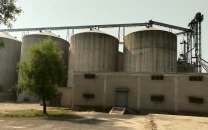Economy is out of woods: monthly outlook
Projects inflation to remain in double digits, likely to settle at 'moderate level'

Pakistan’s economic challenges—higher budget and current account deficits—have been brought down to a manageable level, laying the foundation for higher economic growth, claimed the Finance Ministry’s Economic Advisor wing on Wednesday.
In its monthly economic outlook report, the Finance Ministry’s Economic Advisor wing pronounced that inflation would now settle to a “moderate level,” albeit still in higher double digits.
“The twin deficit is on a downward trajectory signifying better economic management to reduce the macroeconomic imbalances. This lays the foundation for progressing towards higher and sustainable economic growth,” said the finance ministry.
The budget and current account deficits, known as twin deficits and ills of Pakistan’s economy, have pulled down economic growth and are the symptoms of irresponsible expansionary fiscal operations.
It is likely to be the second-last economic outlook report that the finance ministry has released during the interim setup. The elections are scheduled for February 8, and January would be the last month for the caretakers.
The outlook report for December has painted a rosy picture of the economy, but the sustainability of these indicators remains questionable.
The finance ministry said that the inflation outlook for the remainder period of this fiscal year is seen at a moderate level despite the upward revision of administered prices. It added that inflation is anticipated to remain around 27.5% to 28.5% this month and may further ease out to 25% in January. However, this pace is quite high for the majority of Pakistanis.
The finance ministry said that the pace is slowing because of a stable exchange rate, contained aggregate demand, a better supply position, moderation in international commodity prices, and a favourable base effect.
It added the recent decline in petrol and diesel prices is expected to compensate for the inflationary pressure exerted through higher gas prices, as the decline in fuel prices has a significant impact on the common man through reduced transportation and production costs.
The finance ministry said that cautious expenditure management played an instrumental role in controlling non-essential spending; however, the challenge of higher mark-up payments persists. The government spent Rs2.3 trillion or 82% of the net federal income on interest payments during the July-October period of this fiscal year.
Read Improved economy propels PSX to new highs
The finance ministry said that it will continue the current fiscal strategy to achieve set targets, emphasising both revenue enhancement and prudent expenditure control.
The government has brought development spending to a halt—at just Rs76 billion in four months—received Rs970 billion bullet payment of profit from central bank to show lower deficits, according to sources.
The finance ministry said that the “Fiscal side highlights the successful implementation of consolidation measures” in the first four months of FY2024, leading to a significant rise in total revenue receipts that outpaced the growth in expenditures.
It added, the fiscal deficit has been curtailed to 0.8% of GDP or Rs862 billion, and the primary surplus has improved to Rs1.43 trillion during the first four months. The primary surplus continued to improve owing to contained growth in non-markup spending, it added.
On the back of SBP bullet payment and higher petroleum levy collection, net federal revenue receipts increased to Rs2.8 trillion during the first four months of the fiscal year.
The sharp rise in revenues has been largely attributed to a considerable improvement in non-tax revenues that grew by more than 360% in four months. The non-tax revenues increased to Rs1.58 trillion. Similarly, FBR tax collection grew by 29% to Rs2.75 trillion.
The government’s nightmare was higher interest payments that grew 63% to Rs2.23 trillion, whereas non-debt servicing expense increased 19%. The finance ministry said that external sector indicators also showed a strong recovery during the first five months of the fiscal year.
Based on the improved trade balance, the current account posted a deficit of $1.1 billion during the first five months, down from $3.3 billion in the previous year.
It added in the coming months, it is expected that exports would remain at around the current observed level and take advantage of the increase in domestic economic activities and encouraging foreign demand.
Similarly, imports will continue to observe their increasing momentum in the coming months with assumptions of a stable exchange rate and soothed global commodity prices.
However, economic growth is exhibiting mixed performance. Wheat cultivation nearly met its planned area. Notably, Punjab exceeded its wheat sowing target by 2%.
For the Rabi season 2023-24, wheat crop has been cultivated on an estimated area of 8.73 million hectares against the target of nearly 9 million hectares to achieve the production target of 32.3 million tonnes.
The LSM sector is still facing contraction due to record high-interest rates, increasing the cost of energy, and higher input prices.
The performance of the auto-industry remains subdued due to massive increases in input prices and tightened auto finance.
Published in The Express Tribune, December 28th, 2023.
Like Business on Facebook, follow @TribuneBiz on Twitter to stay informed and join in the conversation.



















COMMENTS
Comments are moderated and generally will be posted if they are on-topic and not abusive.
For more information, please see our Comments FAQ